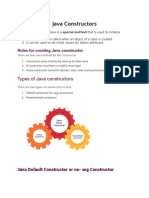Constructors What Is A Constructor?
Constructors What Is A Constructor?
Uploaded by
Bharathi LakshmiCopyright:
Available Formats
Constructors What Is A Constructor?
Constructors What Is A Constructor?
Uploaded by
Bharathi LakshmiOriginal Description:
Original Title
Copyright
Available Formats
Share this document
Did you find this document useful?
Is this content inappropriate?
Copyright:
Available Formats
Constructors What Is A Constructor?
Constructors What Is A Constructor?
Uploaded by
Bharathi LakshmiCopyright:
Available Formats
CONSTRUCTORS
What is a constructor?
A Constructor is a member method of a class which has the same name as that of a
class with no return type. It is used to initialize the instance variable of a class with a legal
initial value and gets involved automatically as soon as the object of a class is created.
Example:
class ConsExamp
{
int n;
ConstExamp()
{
n=10;
}
Public static void main(String arg[])
{
ConsExamp c=new ConstExamp();
System.out.println(c.n);
}
}
Output:
10
In this example ConstExamp is the Class with constructor to initialize the variable n
value as 10. In the main method the value to n is initialized when the object c is created using
the Constructor. The value of n is accessed using the object name and the dot operator and
displayed.
Need of Constructor
To create an instance of a class
To initialize objects of that class type with a legal initial values.
How to Invoke a Constructor?
A constructor is created when we create the object of a class.
How an object is Created?
The object is created using the new operator.
Syntax: -
<class name> <object name> = new <constructor>
Example: -
Student s= new Student();
Class Object new Constructor
Operator
Using the new operator with the Student constructor s object is created and variables
get initialized.
List out the rules to write a constructor.
What are the rules of a constructor?
1. Constructor should have the same class name in which it resides.
2. A constructor cannot be abstract, final, static and synchronized.
3. Access modifiers can be used in the Constructor. Probably public access modifiers are
used in constructors.
Why constructor should be defined public?
What access modifier does constructor use? Why?
A constructor should be defined public due to the following reasons.
1. The object can be created in any method.
2. A constructor might be called from outside the class while creating an object.
What are the function of a constructor?
What are the purpose of a constructor?
Prove a constructor is a member method that can be automatically be called while
creating an object to initialize its elements.
Show that a constructor is a member method that can be automatically be called while
creating an object to initialize its elements.
When we create various objects of a class, the data members are automatically
allocated under each object. To have separate initial values for each object, one may have to
use a member method to initialize the data members and call it separately every time after
creating an object.
Differentiate Constructors and Methods.
Constructors Methods
1 It has the same name as that of the class It has any name other than the class name
Name
2 It has no return type. It has a valid return type
3 They are called at time of object creation They are called when a function for the method
is encountered
4 Doesn’t require to be called in the main class It is called from the main method
5 It is used to initialize instance variables of a It is used to perform a particular task
class
6 They are usually public Any access specifiers can be used
List out the features of constructors.
What are the features of constructors?
1. A constructor has the same name as that of the class name. This allows the constructor
to be invoked automatically on object creation.
2. Constructor is automatically called while creating an object. When an object is
created, the constructor is called implicitly.
3. Constructor has no return type, not even void. A constructor is only used to initialize
the data members. No arithmetical or logical operations are performed in a
constructor. Hence, the return from constructor is not at all required.
4. Constructor is used to initialize the data members or instance variable of a class.
5. Constructor is always public.
6. Constructor is overloaded automatically.
Only a portion that has access to the constructor can use objects of that class. Comment.
Every time when object is created, it is automatically initialized by constructor of
class. Therefore, it is very much necessary for a function using an object that it must have
access to the constructor of the class so that the object being defined could be properly
constructed.
What are the types of Constructor?
Write notes on types of Constructor.
Three types of constructor exist in Java. They are
1. Default Constructor or non-parameterized constructor
2. Parameterized Constructor
3. Copy Constructor
1) Default Constructor or non-parameterized constructor
A constructor that has no parameters is called as Default Constructor or non-
parameterized constructor.
The signature is same as default constructor, however body can have any code
unlike default constructor while the body does nothing.
The non-parameterized constructor used to initialize the instance variables to
zero, null or any default values without specifying is known as default
constructor.
If any constructor is not explicitly defined, then the compiled uses the default
constructor.
Example: - Non-parameterized constructor
Public class Student
{
String name;
Student()
{
name=”Kala”;
}
Public static void main(String ar[])
{
Student s=new Student();
System.out.println(s.name);
}
}
Output: -
Kala
Here without any parameters passed the data member name value is initialized
as “Kala”
Example: - Default Constructor
Public class Student
{
String name;
Public static void main(String ar[])
{
Student s=new Student();
System.out.println(s.name);
}
}
Output: -
““
Here constructor is not explicitly defined. So the default value of string data
type “” is initialized.
2) Parameterized Constructor: -
It is a member function with same name as that of a class name which is used
to initialize the instance variables by passing parametric values at the time of
its creation.
It allows us to initialize the various data elements of different objects with
different values where they are created.
This is achieved by passing different values as arguments to the constructor
when the objects are created.
Defining a constructor with arguments hides the default constructor.
With a parameterized constructor for a class, one must provide initial values as
arguments.
Example: - Parameterized constructor
Public class Student
{
String name;
Student(String nam)
{
name=nam;
}
Public static void main(String ar[])
{
Student s=new Student(“Kala”);
System.out.println(s.name);
}
}
Output: -
Kala
3) Copy Constructor: -
A copy constructor initializes the instance variables of an object by copying
the initial values of the instant variables from another object.
It can be done in two ways
1. Without using Specific constructor.
2. By passing object as parameters.
Example: -
Without using Specific constructor.
Student s=new Student();
Student s1=s;
By passing object as parameters.
Class Student
{
String name;
Student(String nam)
{
name=naml
}
Student(Student stu)
{
name=stu.name;
}
Public static void main(String ar[])
{
Student s=new Student(“Kala”);
Student stu=new Student(s);
}
}
You might also like
- Passport To The MissionDocument168 pagesPassport To The MissionAnjan SapkotaNo ratings yet
- Student Book Answer Key North StarDocument38 pagesStudent Book Answer Key North StarСвета Артеменко100% (1)
- Constructors 1Document12 pagesConstructors 1sheelaNo ratings yet
- Unit 2Document26 pagesUnit 2shamithashibuNo ratings yet
- OOP Chapter 3Document14 pagesOOP Chapter 3ashagerie asfawNo ratings yet
- Object Orientation in JavaDocument53 pagesObject Orientation in Javapillireddy414No ratings yet
- 1 Classes in JAVADocument30 pages1 Classes in JAVABhawana Mayank KothariNo ratings yet
- Java NotesDocument40 pagesJava Notesxajafa1518No ratings yet
- 3 - 1 Basic of Objects and ClassesDocument40 pages3 - 1 Basic of Objects and Classeszander soriianoNo ratings yet
- OOps Chapter 3.Document16 pagesOOps Chapter 3.Magarsaa Qana'iiNo ratings yet
- Java Notes Unit IIDocument12 pagesJava Notes Unit IIaiden.atz78No ratings yet
- Unit 2 NotesDocument24 pagesUnit 2 NotessunhithsirigudiNo ratings yet
- Constructors JavaDocument6 pagesConstructors Javayoung bloodNo ratings yet
- Class&constructorDocument9 pagesClass&constructorragulr239No ratings yet
- Constructors in JavaDocument19 pagesConstructors in JavaAmol AdhangaleNo ratings yet
- Constructors in JavaDocument18 pagesConstructors in JavaAmol AdhangaleNo ratings yet
- Constructors in JavaDocument19 pagesConstructors in JavaAmol AdhangaleNo ratings yet
- 6.object, Class and StringsDocument42 pages6.object, Class and Stringsanshyadav69420No ratings yet
- Unit-2 StringDocument15 pagesUnit-2 StringrvmehtaictspceNo ratings yet
- Java Unit 2 - Objects and ClassesDocument43 pagesJava Unit 2 - Objects and ClassesREDNo ratings yet
- Lecture 6 ExplainedDocument4 pagesLecture 6 ExplainedanwartufailwazirNo ratings yet
- Week 3-LectureA OOPsDocument34 pagesWeek 3-LectureA OOPsFarhan GhafoorNo ratings yet
- Chapter - 2 - Objects and Classes FullDocument61 pagesChapter - 2 - Objects and Classes Fullkidus seyoumNo ratings yet
- ConstructorDocument12 pagesConstructorclashbros563No ratings yet
- BCA Class and ObjectDocument43 pagesBCA Class and ObjectSarthak SrivastavaNo ratings yet
- MZ Chapter - 2 - Objects and Classes Full OopDocument61 pagesMZ Chapter - 2 - Objects and Classes Full Oopkidus seyoumNo ratings yet
- Oop Midterm ReviewerDocument5 pagesOop Midterm ReviewerimdenverdenverNo ratings yet
- Unit 2Document13 pagesUnit 2SUREDDY TANUJA MSCS2018No ratings yet
- Soda Chapter 7Document20 pagesSoda Chapter 7dinesh9866119219No ratings yet
- Constructors in JavaDocument2 pagesConstructors in Javazemo kumarNo ratings yet
- 15-09-2022 Day 9 (Constructor, Types of Constructor, Constructor Chaining)Document4 pages15-09-2022 Day 9 (Constructor, Types of Constructor, Constructor Chaining)Vyshak AppuNo ratings yet
- Notes Unit 3Document18 pagesNotes Unit 3amankureshi060906No ratings yet
- Unit 2Document20 pagesUnit 2motivationallthoughtNo ratings yet
- How To Describe Constructor in JavaDocument6 pagesHow To Describe Constructor in JavaJurilaya SethNo ratings yet
- Unit 2Document67 pagesUnit 2Dr D SuneethaNo ratings yet
- Unit 2 ConstructorsDocument15 pagesUnit 2 ConstructorsKunal KolheNo ratings yet
- Constructors - This - Inherit in Java PDFDocument31 pagesConstructors - This - Inherit in Java PDFSumati BaralNo ratings yet
- NET Unit3 PDFDocument17 pagesNET Unit3 PDFPagLi NisHaNo ratings yet
- 1.constructors in JavaDocument23 pages1.constructors in JavaComputer DepartmentNo ratings yet
- OOPSDocument23 pagesOOPSAtharwa KanungoNo ratings yet
- Java Unit 2Document37 pagesJava Unit 2shamithashibuNo ratings yet
- ConstructorDocument7 pagesConstructorRizvin RifatNo ratings yet
- Dr. Kamal Macwan, Assistant Professor, CSE, Nirma UniversityDocument72 pagesDr. Kamal Macwan, Assistant Professor, CSE, Nirma UniversityBhavya ParikhNo ratings yet
- Java - Constructors: SyntaxDocument2 pagesJava - Constructors: SyntaxNazeeh RzeqatNo ratings yet
- Chapter 4 JavaDocument30 pagesChapter 4 JavaabdishakurNo ratings yet
- Constructor in JavaDocument3 pagesConstructor in JavaSanket BodadeNo ratings yet
- Java Technologies: Topic - Constructor & Constructor OverloadingDocument9 pagesJava Technologies: Topic - Constructor & Constructor OverloadingK Sruti RaniNo ratings yet
- Class7 (Constructor in Java)Document9 pagesClass7 (Constructor in Java)Doton DuttaNo ratings yet
- Object Oriented JavaScriptDocument16 pagesObject Oriented JavaScriptAditya KshirsagarNo ratings yet
- CONSTRUTOR Theory Notes For Class 10Document6 pagesCONSTRUTOR Theory Notes For Class 10trishagupta782No ratings yet
- Constructor Final 10-10-2024Document48 pagesConstructor Final 10-10-2024Putta SwamyNo ratings yet
- Chapter 5 Class, Objects, Methods, Constrctors and InheritancesDocument46 pagesChapter 5 Class, Objects, Methods, Constrctors and InheritancesPranay JhaNo ratings yet
- OOP Session 2 PT 1 SlidesDocument32 pagesOOP Session 2 PT 1 SlidesShame BopeNo ratings yet
- OOP Unit 5 NotesDocument18 pagesOOP Unit 5 Notesharshlaptop001No ratings yet
- What Are Constructors in Java1Document31 pagesWhat Are Constructors in Java1sairanjanchoudhury3060No ratings yet
- 6 Const Inheri Interf Abst (Unit 1)Document35 pages6 Const Inheri Interf Abst (Unit 1)Abhinav KaushikNo ratings yet
- ObjectsDocument7 pagesObjectsabilgen006No ratings yet
- Lecture5 JavaDocument8 pagesLecture5 Javaمعتز العجيليNo ratings yet
- Constructors in JavaDocument16 pagesConstructors in JavanandinipoddarqmsNo ratings yet
- Module 8 - Essentials of Object Oriented ProgrammingDocument51 pagesModule 8 - Essentials of Object Oriented Programmingapi-19796528No ratings yet
- 1.constructors in JavaDocument21 pages1.constructors in JavaAkashdeep BhattacharjeeNo ratings yet
- Java Programming Tutorial With Screen Shots & Many Code ExampleFrom EverandJava Programming Tutorial With Screen Shots & Many Code ExampleNo ratings yet
- Manual For Vermiculture BiotechnologyDocument23 pagesManual For Vermiculture BiotechnologySravan Kaniganti100% (2)
- TRENDs Activity-Sheet-5-Q4 With Quarter 4 NotesDocument8 pagesTRENDs Activity-Sheet-5-Q4 With Quarter 4 Notesarchival diapana644No ratings yet
- Apostila Ingles 7Document5 pagesApostila Ingles 7KEISSY SILVANo ratings yet
- House PropertyDocument10 pagesHouse PropertyquickcabitesNo ratings yet
- CLEAR - Q2 - Math 8 - Week 1Document20 pagesCLEAR - Q2 - Math 8 - Week 1Maria Liza CamoNo ratings yet
- Technical Seminar ReportDocument28 pagesTechnical Seminar Reportpp1708340No ratings yet
- LED Engine 50 Medium 2700K 04 06 20Document2 pagesLED Engine 50 Medium 2700K 04 06 20Arul SankaranNo ratings yet
- A Conversation Between Sayyiduna Abu Bakr and Sayyiduna AliDocument1 pageA Conversation Between Sayyiduna Abu Bakr and Sayyiduna AliSheraz IbrahimNo ratings yet
- Tenses WPS OfficeDocument5 pagesTenses WPS OfficeManas DasNo ratings yet
- 15B21H, 15B21RHDocument4 pages15B21H, 15B21RHGil CabreraNo ratings yet
- Industrial Training Report Pakistan RailwayDocument73 pagesIndustrial Training Report Pakistan Railwaymrsmile4665No ratings yet
- Comparative Analysis of Trust in Financial Institutions Across Four Provinces in PakistanDocument19 pagesComparative Analysis of Trust in Financial Institutions Across Four Provinces in PakistanAudit and Accounting ReviewNo ratings yet
- NSPE - Tips To Passing PE Exam-Static IndeteriminateDocument54 pagesNSPE - Tips To Passing PE Exam-Static Indeteriminategilla2010No ratings yet
- The Effects of Electrical Muscle Stimulation Ems Towards Male Skeletal Muscle MassDocument10 pagesThe Effects of Electrical Muscle Stimulation Ems Towards Male Skeletal Muscle MassAnonymous N0vLeRxNo ratings yet
- Manifest NonUFSFiles Win64Document2 pagesManifest NonUFSFiles Win64Boon SwaggleNo ratings yet
- 2007 Texas Drumline HandbookDocument73 pages2007 Texas Drumline HandbookgilsontrompeteNo ratings yet
- Tally ProjectDocument42 pagesTally ProjectRitu Mathur100% (4)
- SLG-BIOLOGY 2-LG1.4-Applications of DNA ScienceDocument5 pagesSLG-BIOLOGY 2-LG1.4-Applications of DNA ScienceClaudette BisnarNo ratings yet
- Rebirth of The GuardianDocument85 pagesRebirth of The GuardianRobertCummingsNo ratings yet
- HuggingChat: The New Open-Source Chatbot Challenging ChatGPTDocument4 pagesHuggingChat: The New Open-Source Chatbot Challenging ChatGPTMy SocialNo ratings yet
- Eclipse SW Rel - 07-08-55 Customer Release Notes (Low Latency) - 01may2015Document9 pagesEclipse SW Rel - 07-08-55 Customer Release Notes (Low Latency) - 01may2015Sohaib SalihNo ratings yet
- TDS - Bayblend FR3040 EVDocument3 pagesTDS - Bayblend FR3040 EVRachit RanjanNo ratings yet
- Astrophysics IGCSE 9-1 Physics PDFDocument31 pagesAstrophysics IGCSE 9-1 Physics PDFMehrab100% (3)
- Tarot 9. The Hermit - Anne-MarieDocument5 pagesTarot 9. The Hermit - Anne-MarieGohed BraunNo ratings yet
- Paceman Verbal Critique TemplateDocument2 pagesPaceman Verbal Critique TemplateZulfadli Haron100% (1)
- EE/CE 6301: Advanced Digital Logic: Bill SwartzDocument140 pagesEE/CE 6301: Advanced Digital Logic: Bill SwartzGowtham HariNo ratings yet
- T SP OB.تةي1016 2012 OAS MSW EDocument47 pagesT SP OB.تةي1016 2012 OAS MSW Ekhaled syNo ratings yet
- Mankiw10e Lecture Slides ch07Document38 pagesMankiw10e Lecture Slides ch07Afny HnpiNo ratings yet

























































































